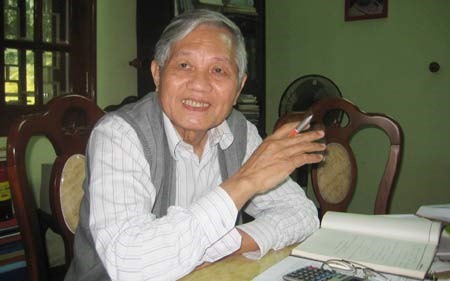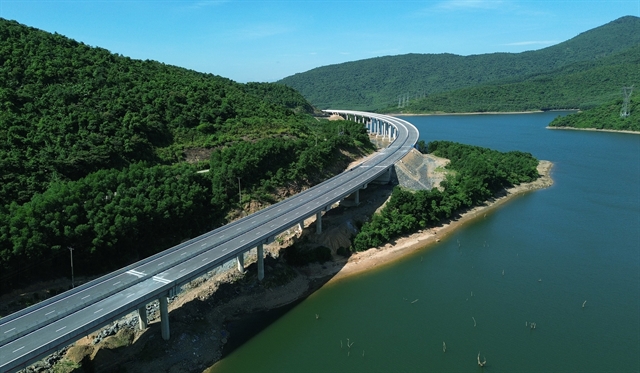 Opinion
Opinion

Former Deputy Minister of Transport, Professor Lã Ngọc Khuê, talks to the Lao Động (Labour) and Việt Nam News newspapers about the glaring imbalance of Việt Nam’s traffic system: the rail market share falling precipitously, the airline sector is overloaded and an abused road transportation system results in huge losses of national resources and higher product prices, as well as worsening pollution and traffic congestion.
 |
| Professor Lã Ngọc Khuê |
Former Deputy Minister of the Ministry of Transport, Professor Lã Ngọc Khuê, talks to the Lao Động (Labour) and Việt Nam News newspapers about the glaring imbalance of Việt Nam’s traffic system: the rail market share falling precipitously, the airline sector is overloaded and an abused road transportation system results in huge losses of national resources and higher product prices, as well as worsening pollution and traffic congestion.
What are the causes of the transportation imbalance?
There are many reasons, but first and foremost, it’s due to a wrong mindset in the design and implementation of transport planning in past decades.
We have failed to realise that the development of transport systems cannot hinge on developing each sector separately, forgetting that the ultimate goal is to create a synchronised system in which components support each other and make for a consolidated whole enabling sustainable economic development.
In 40 years since the đổi mới (Reform), we have not invested in a single metre of commercially viable rail.
What constitutes a synchronised transportation system?
The term was mentioned in the Party’s 11th Central Conference Resolution issued last December. However, it has not been defined in any official documents.
But, to my understanding, "synchronised" doesn’t necessarily mean that every component of the system is on the same level or receives the same treatment and priority.
A synchronised system is one that can fully utilise the strengths of every mode of transport. The main component in each case must play its designated role and be sufficiently strong to lead the system.
Railway, aviation, waterway, maritime, and road transport can be seen as five fingers. Lawmakers must be fully aware of what sector serves as the proverbial thumb in this analogy.
So, in your opinion, the railway sector should be the "thumb"?
In terms of efficiency, competitiveness, sustainability, reliability and safety, railway transportation can deliver it all.
Marx said transportation is a special sector, it doesn’t create useful goods, but it changes the location of goods. Transportation costs are accounted for in the price of goods, so cutting these costs would mean more competitive prices.
On a macroeconomics level, the portion of GDP that goes into transportation is a telling index of an economy’s efficiency and competitiveness. According to World Bank’s 2014 data, logistics costs took up 22 per cent of Việt Nam’s GDP, while 14 per cent went to transportation costs. That’s an abnormal rate I’d say.
Against developed countries like Canada’s 3.4-3.5 per cent, or Japan’s 2 per cent of GDP that go into transportation costs, our figure is abnormal and a reconsideration is in order.
In addition, railway has an economic edge in terms of fuel consumption, land and materials, over other modes of transportation, especially road transportation, which is particuarly not environment-friendly.
Also, as a result of many BOT projects, road tolls are sometimes as high as fuel costs. If we count costs of pollution, traffic accidents and congestionj, then the waste in transportation is exorbitant.
In 2016, the number of cars and motorbikes in Việt Nam grew by 400,000 and 3 million, respectively, at an estimated import value of at least US$10 billion. And unlike other countries, we virtually don’t have an automobile industry, so there’s no way to recover such spending. Our transportation activities inadvertently become a lucrative market for foreign companies. It’s such a shame.
How can we establish the railway’s leading role so that it enhances the safety of the whole traffic system?
Our efforts have proved successful in reducing the number of traffic accidents, as well as the number of deaths and injuries. However, the results were still not as expected. The Government focussed on four factors to boost safety, including the mentality of traffic participants, the quality of the drivers, of the infrastructure and the vehicles. I think we should add in another factor to focus on, the intrinsic safety of operations.
The advantages of road transportation is its wide-reaching network, but the large number of vehicles on the roads easily lead to chaos – unreliable, unsafe – and should be utilised on short to medium routes, with small cargo loads. Roads should be just tributaries, bringing goods to railway stations. The railway, in this analogy, should be the main river, transporting large loads of goods over long distances, according to a tight schedule.
The "chaos" can only be reined in by an entity capable of leading and taking charge.
What pressing measures should we take?
The Japanese say railways must assume the central role during development and growth, even serving as a basis of an economy. The Chinese consider railways the main arteriers of the economy, while we have been neglecting this sector for four decades.
The railway sector’s sad state of affairs is the underlying and fundamental cause of the lack of equilibrium in our transportation system.
We must reinstate its importance, at least along national economic corridors and the strategic North-South axis. It might be late, but the National Assembly’s Standing Committee has declared "it is time to make breakthrough progress to put the railway in its rightful position as the backbone of traffic development", adding that any additional delay is unacceptable.
The railway sector currently commands only about 2 per cent of the transportation market, and privatisation would be ideal when the railway market reaches at least 10-20 per cent. But it’s not totally impossible. For example, Japanese investors are eyeing the underground metro being built at the Bến Thành Central station in HCM City. Private investors could be allowed to make use of the Hà Nội bus station’s abundant 18ha of land: a landmark tower erected there could be a viable option. Private investors could utilise existing infrastructure on popular routes of freight or passenger transportation, like Vinh–Hà Nội, Hà Nội–Lào Cai, or HCM City–Nha Trang, to set up logistics services.
The most difficult challenge remains the limited State budget and privatisation challenge?
It’s a common misconception regarding railway investment. The cost of building 1km of the four-lane HCM City-Trung Lương Highway reached $16 million, and estimated cost for 1km of the planned four-lane North-South Highway is about $10 million. On the other hand, take, for example, the Hạ Long–Cái Lân standard gauge two-track railway (1.435m) in the northern region costs just $6 million per km. We can easily see that building railways is cheaper, and at most, equal to the costs of roads and highways.
In addition, highways also have high land use costs. The six-lane Hà Nội–Hải Phòng Expressway takes up 100m in width, four-lane expressways takes up 60m, while double-track rail occupies no more than 20m in width.
Regarding privatisation, I maintain that it’s not actually the key solution to the problem. Unlike other countries, private investors in BOT traffic projects in Việt Nam have to borrow money from banks to carry out such projects. Taking in commercial banks’ interest rates, the actual capital needed for a project swells so that it’s more expensive than projects using government bonds. And as we have witnessed recently, social disturbances and public outrage as a result of BOT projects’ inappropriate fee collection is also a matter of concern.
The viable way, in my own opinion, is for the Government to use its bonds to invest and upgrade railway infrastructure, then transfer operating rights to private enterprises, then gradually equitise and privatise state-owned enterprises. Using this method, the State does not have to spend much on operational costs, and also will be able to recover the initial capital used in the infrastructure development.
The Ministry of Transport has asked the Government to allot VNĐ7 trillion (US$308.6 million) from the State Budget for medium-term investment in the railway sector, mostly upgrading degraded components like bridges and tracks on the north-south route. The sum is just the minimal amount needed to keep the railway’s going, but not nearly enough to revitalise the sector.
Aside from domestic needs for a revitalised railway sector, what else should the sector do in the context of deeper international integration?
Our neighbour, China, is planning to connect the southwestern part of the country with countries in Southeast Asia. The envisioned railway will run directly to Laos, Thailand, then to Malaysia and Thailand. Singapore and Malaysia agreed in 2010 to build the Singapore–Kuala Lumpur high-speed rail. Cambodia will also likely build a railway connecting Phnompenh and Bangkok.
In this context, with all this activity around us, I think Việt Nam can’t sit this one out. This will be a good opportunity for us to boost tourism development as well as trade integration. — VNS




